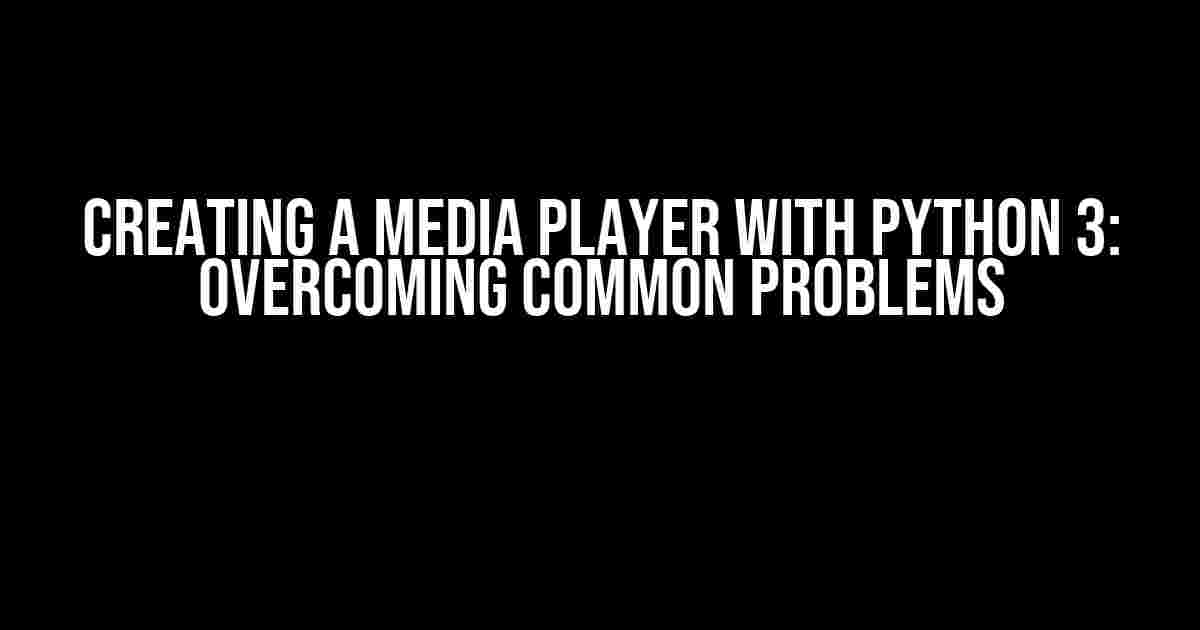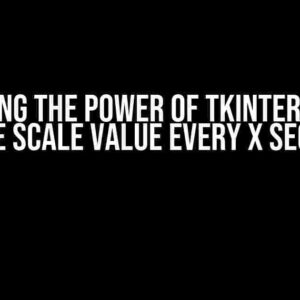Are you tired of using boring media players that lack the features you need? Do you want to create a custom media player that meets your specific requirements? Look no further! In this article, we’ll guide you through the process of creating a media player using Python 3, and troubleshoot common problems that you may encounter along the way.
Getting Started
To create a media player with Python 3, you’ll need to have the following installed on your system:
- Python 3.x (preferably the latest version)
- Pip (Python package manager)
- A GUI framework (we’ll use Tkinter for this example)
- A media processing library (we’ll use VLC.py)
Once you have these installed, let’s dive into the code!
Step 1: Importing Necessary Modules
import tkinter as tk
import vlc
In this example, we’re importing the Tkinter module for creating the GUI and the VLC.py module for media processing.
Step 2: Creating the GUI
root = tk.Tk()
root.title("My Media Player")
root.geometry("500x300")
# Create a frame for the video
video_frame = tk.Frame(root, bg="black")
video_frame.pack(fill="both", expand=True)
# Create a label for the video
video_label = tk.Label(video_frame, text="Video will play here")
video_label.pack(fill="both", expand=True)
# Create a frame for the controls
control_frame = tk.Frame(root, bg="gray")
control_frame.pack(fill="x")
# Create buttons for play, pause, and stop
play_button = tk.Button(control_frame, text="Play", command=play_video)
pause_button = tk.Button(control_frame, text="Pause", command=pause_video)
stop_button = tk.Button(control_frame, text="Stop", command=stop_video)
play_button.pack(side="left")
pause_button.pack(side="left")
stop_button.pack(side="left")
In this example, we’re creating a GUI with a video frame, a label for displaying the video, and a control frame with play, pause, and stop buttons.
Step 3: Creating the Media Player
def play_video():
media = vlc.MediaPlayer("path/to/video.mp4")
media.play()
def pause_video():
media.pause()
def stop_video():
media.stop()
In this example, we’re creating functions for playing, pausing, and stopping the video using the VLC.py module.
Common Problems and Solutions
Now that we have our media player up and running, let’s tackle some common problems that you may encounter:
Problem 1: Video Not Playing
If your video is not playing, check the following:
- Make sure the video file path is correct.
- Ensure that the video file is in a compatible format (e.g., MP4, AVI, etc.).
- Check if the VLC.py module is installed correctly.
Problem 2: Audio Not Working
If your audio is not working, check the following:
- Make sure the audio file path is correct.
- Ensure that the audio file is in a compatible format (e.g., MP3, WAV, etc.).
- Check if the VLC.py module is configured to play audio correctly.
Problem 3: GUI Not Responding
If your GUI is not responding, check the following:
- Make sure the Tkinter module is installed correctly.
- Check if the GUI code is correct and formatted properly.
- Ensure that the GUI is not blocked by any infinite loops or long-running processes.
Troubleshooting Tips
Here are some general troubleshooting tips to keep in mind:
- Check the console output for any error messages.
- Use print statements to debug your code.
- Test individual components of your code to isolate the problem.
- Search online for similar problems and solutions.
- Consult the official documentation for the libraries and modules you’re using.
Conclusion
Creating a media player with Python 3 can be a fun and rewarding project, but it requires attention to detail and troubleshooting skills. By following the steps outlined in this article and troubleshooting common problems, you can create a custom media player that meets your specific needs. Happy coding!
| Module | Description |
|---|---|
| Tkinter | A Python binding to the Tk GUI toolkit. |
| VLC.py | A Python binding to the VLC media player. |
Remember to stay calm and patient when troubleshooting, and don’t hesitate to ask for help if you’re stuck. Good luck, and happy coding!
Frequently Asked Question
Get answers to the most commonly asked questions about creating a media player with Python 3.
Why is my Python 3 media player not playing audio files?
This might be due to missing or incorrect dependencies. Ensure you have installed the necessary libraries, such as `pygame` or `pyglet`, and that they are properly imported in your script. Also, check if the audio file path is correct and the file format is supported by your media player.
How do I create a GUI for my Python 3 media player?
You can create a GUI for your media player using a Python GUI framework such as Tkinter, PyQt, or wxPython. Design your interface using widgets and layouts, and bind events to functions that control the media player’s behavior. You can also use a GUI builder tool like PAGE or PySimpleGUI to simplify the process.
Why is my media player not responding to keyboard or mouse events?
This might be due to incorrect event binding or handling. Ensure that you have correctly bound the events to the corresponding functions, and that the functions are properly defined and executed. Also, check if there are any conflicting events or scripts that might be interfering with your media player’s event handling.
How do I add video playback support to my Python 3 media player?
To add video playback support, you’ll need to use a library that supports video playback, such as `vlc.py` or `pyav`. You’ll need to install the necessary dependencies and import the library in your script. Then, create a function to play the video file using the library’s API, and bind the function to a GUI event or button.
Why is my media player crashing or throwing errors?
This might be due to various reasons such as incorrect syntax, invalid file formats, or missing dependencies. Check the error messages and debug your code to identify the issue. Ensure that your code is properly indented, and that you have handled exceptions and errors properly. Also, test your media player with different file formats and inputs to identify the root cause of the issue.





